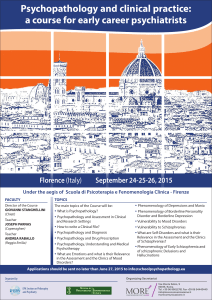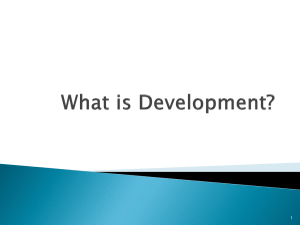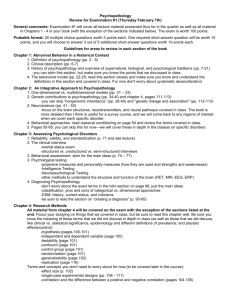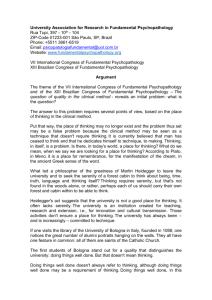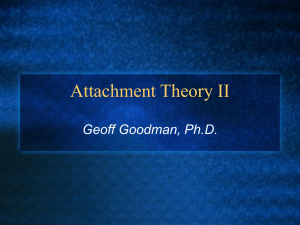Object Relations Theories
advertisement
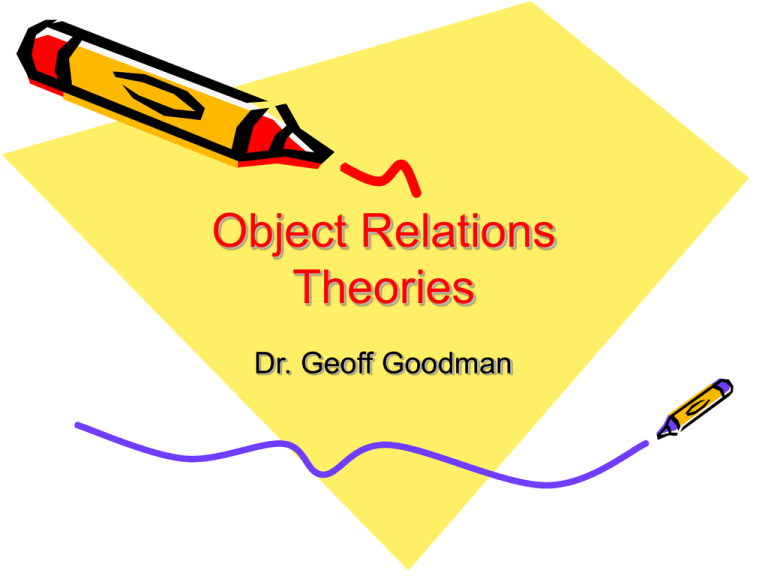
Object Relations Theories Dr. Geoff Goodman I. Introduction to Object Relations Theories • A. Obtain home, phone number, e-mail address • B. Previous exposure to object relations theories • C. Course requirement • D. Review of syllabus II. Theoretical and Historical Overview • • • • • A. Freud B. Klein C. Mahler D. Kernberg E. Other important theoreticians Other Important Theoreticians • • • • • • • • 1. Fairbarn 2. Sullivan 3. Winnicott 4. Guntrip 5. Balint 6. Jacobson 7. Green 8. Kohut III. What is Object Relations: Definitions A. “Theories, or aspects of theories, concerned with exploring the relationship between real, external people and internal images and residues of relations with them, and the significance of these residues for psychic functioning” (Greenberg & Mitchell, 1983, p.12). Object Relations: Definitions Continued B. Three definitions by Kernberg (1976a) 1. Understanding present interpersonal relations in terms of past ones 2. Construction of mental representations of dyadic “self” and “object” relationships a. baby and mother relationship b. triadic relationships c. multiple relationships within and outside of the family Object Relations: Definitions Continued 3. Specific approaches or theories A. Kleinian school B. British Independent school C. Integrations of these two schools IV. Shared Assumptions of Most Object Relations Theories A. Severe pathology has preoedipal origins (ages 0-3) 1. normal autistic phase 2. normal symbiotic phase 3. paranoid-schizoid position 4. depressive position Shared Assumptions of Most Object Relations Theories Continued… • B. Object relations become increasingly complex over time • C. Developmental stages are culturally invariant but can be distorted by personal experiences • D. Early object relations repeated and fixed for life Continued… • E. Disturbances in object relations predict forms of psychopathology • F. Patient relations with therapists reflect healthy and pathological aspects of early relationship patterns V. Critiques of These Assumptions A. Sexual and physical abuse and other types of trauma can produce severe psychopathology at later stages of development 1. early risk factors might still play a role 2. early resilience factors might still play a role Critiques Continued… • B. Different aspects of object relations can increase in complexity or remain static • 1. capacity for investment in people • 2. capacity for investment in values and morals • 3. affect tone of relationship paradigms • 4. complexity of object representations (high for BPD) • 5. understanding of social causality Critiques Continued… C. Non-Western views of the self 1. Relational and collectivist, not individualistic 2. Emphasis on conformity and fitting in rather than distinguishing oneself 3. “Psychoanalytic ideas will need to be broadened considerably in order to encompass the very different early environments which infants and children from other cultures experience” (Fonagy & Target, 2003, p. 13). Critiques Continued… D. Effects of later life events on the development of novel object relations (e.g., loss, romantic relationship) E. Situational stressors can impact the development of psychopathology F. Real aspects of therapist can powerfully affect the interaction structure of the therapist- patient relationship (see Keiha’s dissertation) VI. Dimensions of Variation in Object Relations Theories A. The function of object relations 1. need-gratifying (drive theory) 2. object- seeking (systems theory) 3. controversy between perception of object relations as creation or re-creation of specific modes of relatedness with others vs. drive discharge Continued… 4. Drive Theorists • A. Freud • B. Klein • C. Mahler 5. Interpersonal theorists A. Sullivan B. Fairbairn C. Bowlby B. Endogenous/exogenous role in object relations 1. 2. 3. 4. heavy influence of sexual and aggressive drives heavy influence of real external events and relationships controversy between perception of object relations as drive-influenced distortions of real relationships (funhouse of mirrors) vs. accommodations to real relationships (reality-based perceptions) transactional model--interactions of genetics and environment C. Developmental models used 1. stage theory--development along a fixed, unitary developmental line (fixation and regression) 2. pathways model--development can take many forms, both adaptive and maladaptive, based on a risk/resilience gradient 3. mixed models D. Goodness of human nature 1. “Guilty Man”- conflict produces psychopathology 2. “Tragic Man”- deficit produces psychopathology 3. controversy between failures of integration (conflict because of splitting) vs. failures of internalization (deficit because of failures in mirroring) VII. Specific Theorists that Illustrate These Variations A. Melanie Klein 1. paranoid-schizoid position 2. depressive position 3. drive theorists who believe in infant’s capacity for inherent object-sucking Melanie Klein Continued… 4. sexual and aggressive drives inevitably distort the development of object relations (mother is infant in drag) 5. stage theory used but modified to accommodate positions that reflect momentto-moment shifts in relating 6. psychopathology arises out of conflicts derived from good and bad mental representations B. John Bowlby 1. 2. 3. 4. 5. secure attachment (B) anxious-avoidant attachment (A) anxious-resistant attachment (C) disorganized attachment (D) systems theorist who believed in infant’s capacity for inherent objectseeking (attachment) Bowlby Continued… 6. infants accommodate lapses in caregiver sensitivity and responsiveness to maximize experience of felt security (buildup of expectations based on procedural memories) 7. developmental pathways model used (A-BC-D) 8. psychopathology arises out of deficits in caregiving and consequent defensive exclusion, cognitive disconnection, and segregated systems
